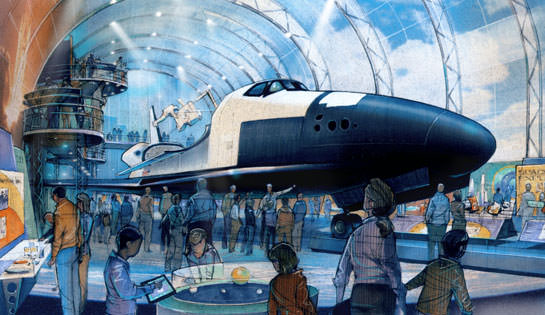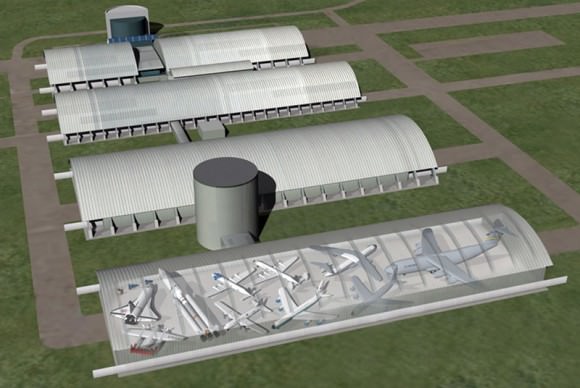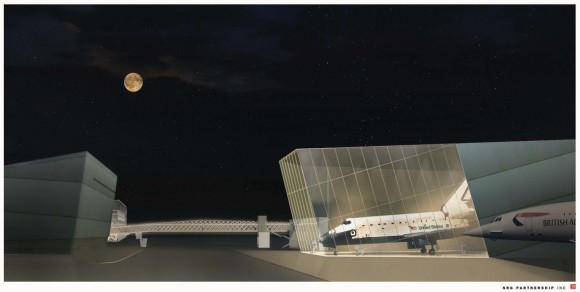The Pathways Interns of NASA’s Johnson Space Center have been working very hard lately with the successful Orion launches. They decided it was time to celebrate, and to remind everyone what they’re really excited about. So they’ve taken the hit song “All About that Bass,” by Meghan Trainor, and rewritten the lyrics to be a little more appropriate for their purpose. They wanted to raise excitement over the successful Orion tests, and promote the amazing work going on at NASA and Johnson Space Center. They’re bringing rockets back!
Is NASA Dead? Not Even Close.
If you’re a frequent reader of Universe Today you know that, despite the end of the Shuttle program and the constant battle for a piece of the federal budget, NASA has a lot on their plate for future space exploration missions. But there are still a lot of people among the general public who think that the U.S. space administration is “dead,” or, at the very least, in the process of dying. Which is unfortunate because there’s actually a lot going on, both in space and in development on the ground.
The video above, released Monday by Johnson Space Center, shows highlights from 2013 as well as some of the many things NASA has in progress. As anyone can see, rumors of its death have been greatly exaggerated! (By whom I’m still not quite sure.)
Visit the Johnson Space Center site for more information and updates on current and future missions.
(Tip of the visor to astronaut Clayton Anderson for the video!)
NASA Employees Tell LGBTQ Youth: “It Gets Better”
“Being gay doesn’t necessarily define you, it’s just one factor of who you are.”
– NASA Johnson Space Center Deputy Chief of Staff
For over 50 years NASA has inspired people of all ages around the world to set their sights above the sky, to believe in the power of innovation and to not only hope for a better future, but to make it happen. Now, in celebration of LGBT Equality Month, team members from NASA’s Johnson Space Center (and a certain former Starfleet helmsman) tell young people struggling with their identity, “it gets better.”
It’s yet another example of NASA’s commitment to inspiration — regardless of your orientation.
The NASA JSC It Gets Better video is a video project created by the “Out & Allied @ JSC Employee Resource Group” of NASA’s Johnson Space Center. It was created as an outreach tool primarily directed at high school and college-aged lesbian, gay, bisexual, transgender, queer and questioning (LGBTQ) individuals who are victims of bullying and/or have been affected by bullying. This video sends the message to current and future NASA employees that it is OK to be LGBTQ, and that NASA JSC management supports and encourages an inclusive, diverse workforce in our workplace.
For more info about Johnson Space Center, click here, and learn more about the It Gets Better project here.
Established in 1961 as the Manned Spaceflight Center, NASA’s Johnson Space Center has served as a hub of human spaceflight activity for more than half a century. As the nucleus of the nation’s astronaut corps and home to International Space Station mission operations and a host of future space developments, the center plays a pivotal role in surpassing the physical boundaries of Earth and enhancing technological and scientific knowledge to benefit all of humankind.
Shuttle Replica Departs Kennedy for Ocean Voyage to Houston on a Barge – Enterprise is Next
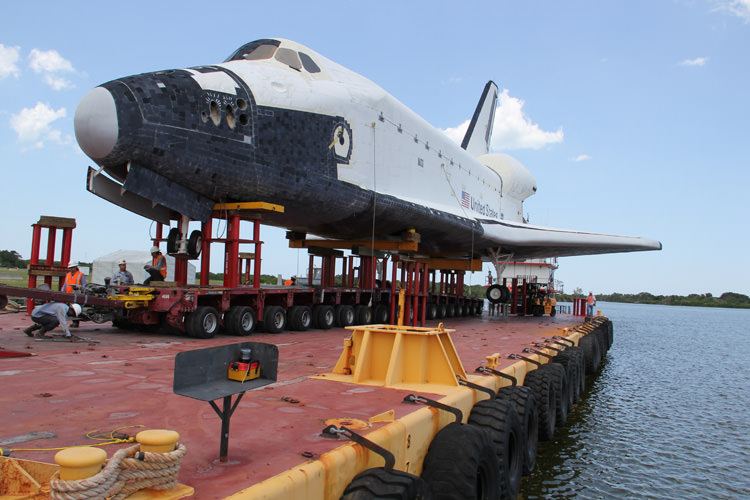
[/caption]
A high fidelity replica of a NASA Space Shuttle orbiter has set off today, May 24, on an ocean going voyage by barge for NASA’s Johnson Space Center in Houston, Texas. This trip by the Shuttle replica gives a taste of what’s to come for the upcoming barge journey by Space Shuttle Enterprise around the southern tip of Manhattan in early June.
The replica model formerly named “Explorer” departed early this morning from the turn basin at the Kennedy Space Center in Florida in the shadow of the iconic vehicle Assembly Building (VAB) where the real Space Shuttles and Apollo Moon rockets were assembled for launch.
The space shuttle replica first moved through the inter-costal waterway and then set sail out from Port Canaveral and into the Atlantic Ocean this afternoon for about a week’s voyage that will take her southwards around the coastline of the Florida peninsula and then into the Gulf of Mexico on a heading for Houston, Texas.

The shuttle model was towed onto the barge at KSC Tuesday afternoon (May 23) by Beyel Bros. Crane and Rigging who are responsible for loading it. Beyel workers then welded the shuttle model to the deck of the barge.
None of the real space shuttles had ever been located at this position at KSC before near the VAB and waterways and provided truly amazing and unique photographic opportunities.
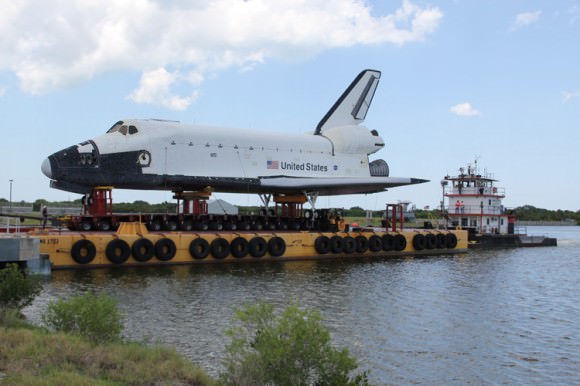
The full scale replica – with the moniker Explorer removed – is being transported to her permanent new home at Space Center Houston, the visitor complex at NASA’s Johnson Space Center in Texas.
It will arrive in Houston around June 1, depending on the weather, where a free three day public arrival welcome “Shuttlebration Weekend” is planned.
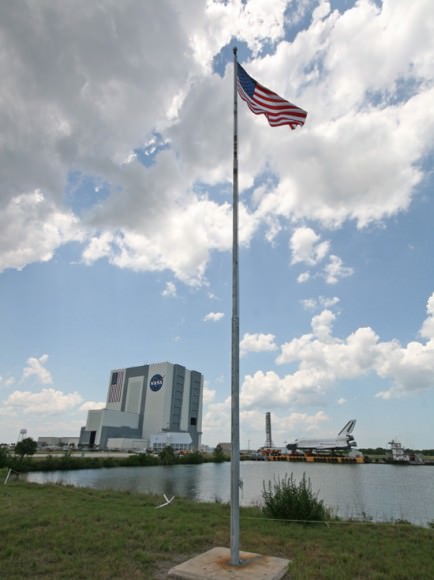
The Explorer had been on display alongside a gantry like tower at the Kennedy Space Center Visitor Complex (KSCVC) since 1993 and was enjoyed by millions of tourists since then along with full scale replica versions of the shuttle’s twin solid rocket boosters and huge external fuel tank.
The Explorer model was built was built in Apopka, Fla., by Guard Lee using schematics and blueprints provided by NASA. It’s the next best thing to having a real space shuttle. The model’s length is 122.7 feet, its height is 54 feet, and its wingspan is 78 feet.
Having been up close and inside all three of NASA’s real space shuttles, I can say that the Explorer mockup is an excellent representation of the genuine shuttle orbiters and gives a realistic sense of the airframe, heat shield tiles, cockpit and cavernous cargo bay. At KSCVC, visitors could see directly into the cargo bay housing a satellite. The Michelin wheels were genuine and had actually flown in space.
The Explorer was moved out from Kennedy’s Visitor Center on a 144 wheeled trailer in December 2011 by Beyel Bros to make way for Space Shuttle Atlantis. Atlantis will be towed to the KSC Visitor Complex in November 2012. The Visitor Complex is constructing a humongous permanent new display hall for Atlantis which is slated to open in 2013.
The Space Shuttle program was forcibly shutdown for lack of money at the direction of politicians in Washington DC after the final flight, STS-135, lifted off in July 2011, leaving the US with no capability to transport astronauts or cargo to the International Space Station since then.
The two other remaining space flown shuttles were assigned to museum locations near Washington, DC and Los Angeles. Discovery has already departed in April 2012, flying atop a 747 Jumbo Jet to the Smithsonian Air and Space Museum’s Annex outside Washington, DC.
The Endeavour will take the last cross country airplane trip of the shuttle program in September to her permanent new resting place at the California Science Museum. The Shuttle prototype orbiter Enterprise will be displayed at the Intrepid Air, Sea and Space Museum in New York City starting in mid-July 2012.
The Explorer is a consolation prize of sorts for the Johnson Space Center (JSC), which lost out on the nationwide bidding to display the three now retired NASA Space Shuttles.
JSC was home to the training facilities for the Space Shuttle crews and home to the NASA astronauts who flew aboard the five shuttle orbiters for the 30 year life of the Space Shuttle program. Many folks feel JSC was shortchanged in the shuttle museum home selections process.
On Sunday, June 3, the replica shuttle will arrive at Space Center Houston where it eventually will become part of a unique display telling the story of the Space Shuttle’s achievements and the nationwide team that made them possible. Further details about Space Center Houston – here
Dazzling Photos of the International Space Station Crossing the Moon!
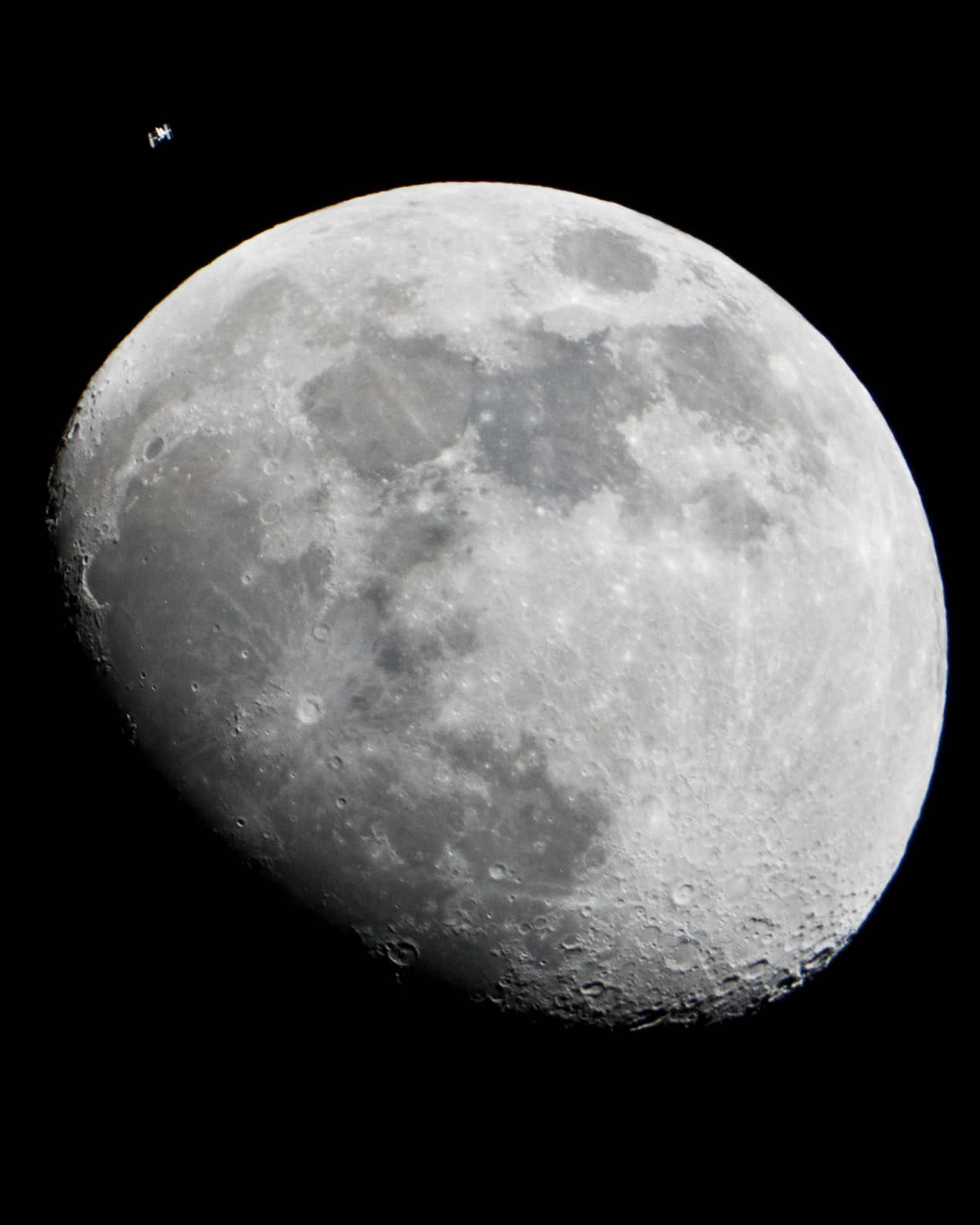
[/caption]
Has the International Space Station (ISS) secretly joined NASA’s newly arrived GRAIL lunar twins orbiting the Moon?
No – but you might think so gazing at these dazzling new images of the Moon and the ISS snapped by a NASA photographer yesterday (Jan. 4) operating from the Johnson Space Center in Houston, Texas.
Check out this remarkable series of NASA photos above and below showing the ISS and her crew of six humans crossing the face of Earth’s Moon above the skies over Houston, Texas. And see my shot below of the Moon near Jupiter – in conjunction- taken just after the two GRAIL spacecraft achieved lunar orbit on New Year’s weekend.
In the photo above, the ISS is visible at the upper left during the early evening of Jan. 4, and almost looks like it’s in orbit around the Moon. In fact the ISS is still circling about 248 miles (391 kilometers) above Earth with the multinational Expedition 30 crew of astronauts and cosmonauts hailing from the US, Russia and Holland.
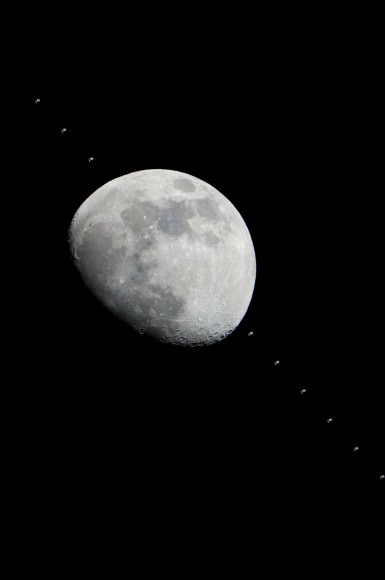
This composite of images of the International Space Station flying over the Houston area show the progress of the station as it crossed the face of the moon in the early evening of Jan. 4, 2012 over NASA’s Johnson Space Center, Houston, Texas. Credit: NASA
click to enlarge
The amazing photo here is a composite image showing the ISS transiting the Moon’s near side above Houston in the evening hours of Jan 4.
The ISS is the brightest object in the night sky and easily visible to the naked eye if it’s in sight.
With a pair of binoculars, it’s even possible to see some of the stations structure like the solar panels, truss segments and modules.
Check this NASA Website for ISS viewing in your area.
How many of you have witnessed a sighting of the ISS?
It’s a very cool experience !
NASA says that some especially good and long views of the ISS lasting up to 6 minutes may be possible in the central time zone on Friday, Jan 6 – depending on the weather and your location.
And don’t forget to check out the spectacular photos of Comet Lovejoy recently shot by Expedition 30 Commander Dan Burbank aboard the ISS – through the Darth Vader like Cupola dome, and collected here
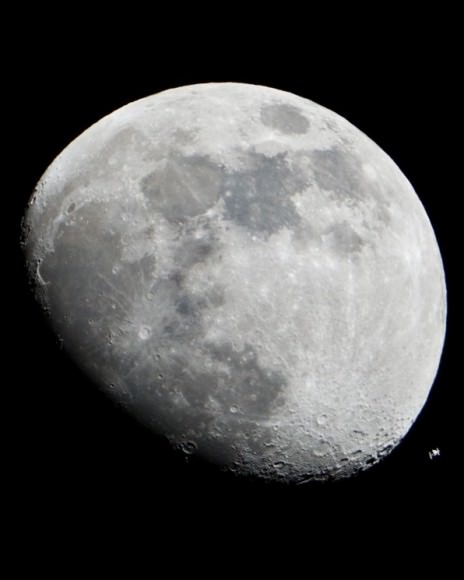

Taken near Princeton, NJ after both GRAIL spacecraft achieved lunar orbit after LOI - Lunar Orbit Insertion- burns on New Year’s weekend 2012. Credit: Ken Kremer
‘In Flight’ Shuttle Orbiter retirement display planned by Kennedy Space Center Visitor Complex
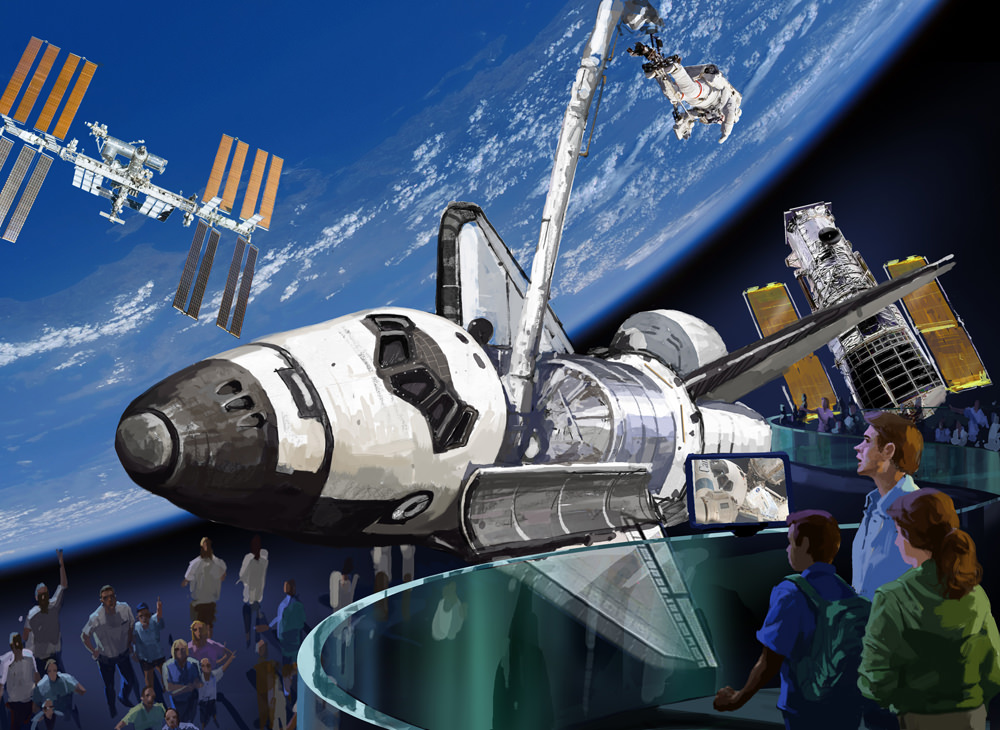
[/caption]
‘In Flight’ …. That’s the heart of the dramatic plan to showcase a Space Shuttle Orbiter being proposed by the Kennedy Space Center Visitor Complex (KSCVC) as they seek to win the heated competition to become the permanent new home to one of NASA’s three soon to be retired Orbiters.
Honoring the past, embracing the future of human spaceflight and celebrating the spirit of human determination; this is the new theme planned by the Visitor Complex at Kennedy so that guests of all ages will feel like they are embarking on an interactive space expedition. See the ‘In Flight’ graphic illustration above.
Some 21 science centers and museums across the US are bidding for the once in a lifetime chance to house NASA’s surviving shuttle orbiters; Discovery, Atlantis and Endeavour.
“The Kennedy Space Center is the home of the Space Shuttle unlike all the other places,” said Bill Moore, Chief Operating Officer of KSCVC. I spoke to Moore at KSC in an exclusive interview for Universe Today.
“All of the shuttle missions have launched from here, not anywhere else. So Kennedy is their home. And they all eventually come back here at the end of each mission. So we have a compelling story to tell about their history at KSC and the future.”
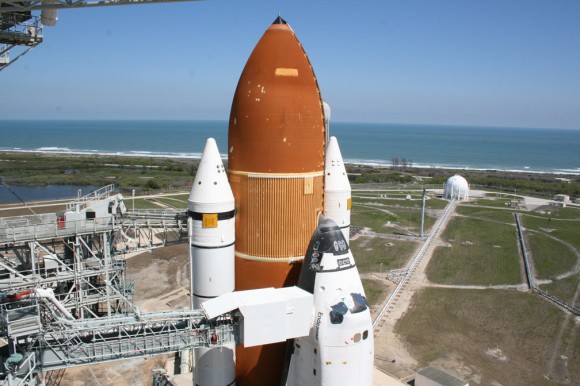
Shuttle orbiter display at the Kennedy Space Center Visitor Complex will include many shuttle artifacts, including the White Room - shown here attached to shuttle Endeavour. Astronauts walk
through the white room to enter the shuttle crew cabin. Credit: Ken Kremer
The Smithsonian National Air & Space Museum, Washington, D.C., has long been expected to be picked as the retirement home for Space Shuttle Discovery, the oldest orbiter. That leaves Atlantis and Endeavour remaining in the bidding war. Since the Smithsonian currently displays the shuttle Enterprise, that unflown orbiter would also be up for grabs by another venue.
NASA Administrator Charles Bolden will decide the final site selections. He is scheduled to announce the winner of the nationwide competition on April 12, which is the 30th anniversary of the first shuttle flight (STS-1) by Columbia on April, 12, 1981.
Another location that plays a pivoital role in the U.S. space program is NASA’s Johnson Space Center in Houston, Texas, home to Mission Control. Johnson Space Center is also home base for the shuttle astronauts and houses the facilities where they train for space missions. The Johnson Visitor Center – Space Center Houston – has proposed a 53,000 square foot pavilion with interactive exhibits.
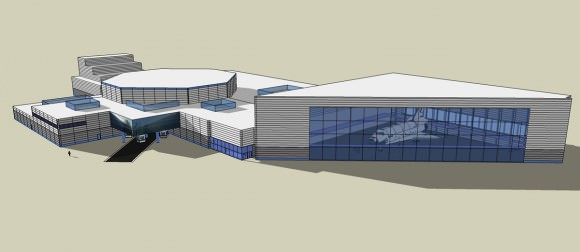
Many of those who work on space projects feel strongly that two of the orbiters should unquestionably be awarded to the Kennedy Space Center (KSC) and the Johnson Space Center JSC) since these are the two locations most intimately involved with the Space Shuttle program. All the crews were trained at JSC and blasted off to space from KSC.
Among the other contenders in the running to house an orbiter are; the Intrepid Sea-Air-Space Museum in New York City; the Adler Planetarium in Chicago; the National Museum of the Air Force in Dayton, Ohio; the U.S. Space & Rocket Center in Huntsville, Alabama; the Museum of Flight in Seattle.
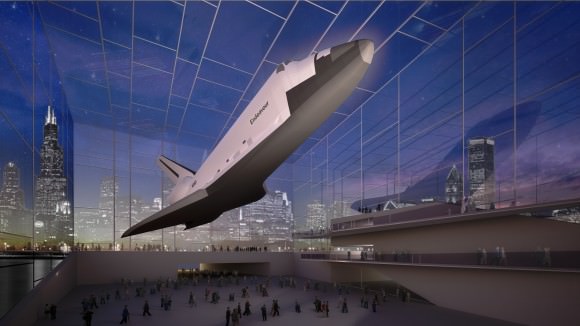
At the Kennedy Visitor Complex, a brand new 64,000 square-foot hall would be constructed to display the orbiter “In Flight”. The exhibit would engage viewers in an up close experience to see how the vehicle actually worked in space and also feature its major accomplishments; such as building the International Space Station (ISS) and upgrading the Hubble Space Telescope.
The orbiter home is projected to cost some $100 million and would be the marquee element of the master plan entailing a transformative overhaul of the entire visitor complex at Kennedy, according to Moore.
The KSCVC concept is outlined in a thick book with extensively detailed story boards and drawings. Clearly, a lot of hard work and thought has gone into designing KSCVC’s proposal to house an orbiter and integrate it with a complete renovation and update of the spaceport tour facilities. The goal is to satisfy the interests of the whole family- not just hard core space geeks.
“We (KSCVC) will display the orbiter tilted, like it is flying in space and at work. Because that’s the way people think about the orbiter – working in space. Not sitting on the ground on three wheels,” Moore explained to me.
“So, our job at KSC is to show the shuttle’s working time as it is flying in space. The payload bay doors will be open and the robotic arm will be extended. Some type of cargo will be inside. We will also show the Hubble and the ISS with models, giant video screens and murals, because we think that’s key to understanding the role of the shuttle.”
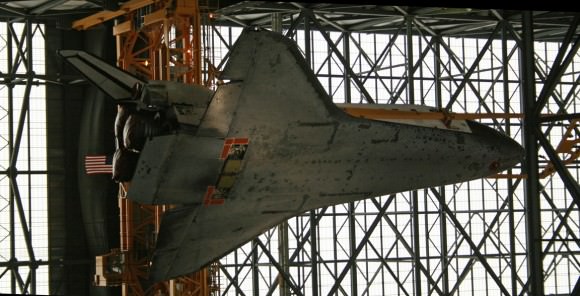
This tilted view of Space Shuttle Endeavour ‘In Flight’ may give an impression of what visitors might experience in the shuttle orbiter exhibit planned by the Kennedy Space Center Visitor Complex if they are selected as a permanent home for the retired vehicle. I snapped this photo inside the Vehicle Assembly Building while Endeavour was vertically tilted and being hoisted by cables in mid-air. The photo has been rotated 90 degrees to look as though it were horizontal. Credit: Ken Kremer
Moore told me that this will be the largest building ever constructed at KSCVC, even bigger than the popular Shuttle Launch Experience completed a few years back.
“When people come into the exhibit, their first view will be to see the orbiter as though someone would see it by looking out from the ISS, up against a gorgeous backdrop of the Earth, the Sky and the Universe.”
“The point is to make you believe that you are actually seeing the orbiter in space. Visitors will be able to view the orbiter from many different angles,” said Moore.
The shuttle will be shown as it really looks and is flown with the heat shield tiles, with all its scorch marks, pits, scars and imperfections.
“We do not want the orbiter to be polished to a pristine state,” Moore stated firmly.
“We want to expose as many people as possible from around the world to this wonderful vehicle and to what’s happened up there in space.”
“The vehicle is just part of the story. The story is much bigger.
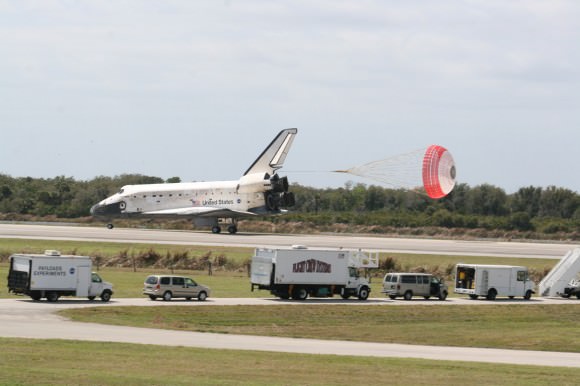
Space Shuttle Discovery concluded her magnificent final journey with a safe landing on March 9, 2011 at the Kennedy Space Center in Florida. Discovery is the first shuttle to be retired and will likely be housed at the Smithsonian National Air and Space Museum in Washington, DC. Credit: Ken Kremer
“The purpose of the display building is that we want to show the whole story of what the shuttle has done and all the major milestones. The people who processed and cared for the orbiters are also part of the story,” Moore amplified.
“We will remember and show the story of those who made the ultimate sacrifice, what we learned from the accidents and then fixed lots of issues to get to a better flight system.”
I asked Moore, when will the exhibit open ? “I would like to open the exhibit by mid to late 2013,” he replied.
The orbiter will be showcased with components from the shuttle’s history. “We have the beanie cap, the white room and a fairly large collection of many other artifacts, parts and items beyond just the orbiter that will be used to tell the story of the shuttle program.”
“The shuttle story covers 30 remarkable years,” said Moore.
Only two flights remain until the shuttles are forcibly retired for lack of many and some say willpower to continue exploring.
The final flight of Endeavour on the STS-134 mission is set for April 19. Atlantis is honored with the shuttle programs very last mission, STS-135, slated for late June 2011.
Discovery just landed on her historic final mission on March 9 – a thrilling and bittersweet experience for all who work and report on the shuttle program. Discovery is being decommissioned and now belongs to history although she has a lot of life left in her.
Stay tuned for the April 12 announcement of the Orbiter homes selected.
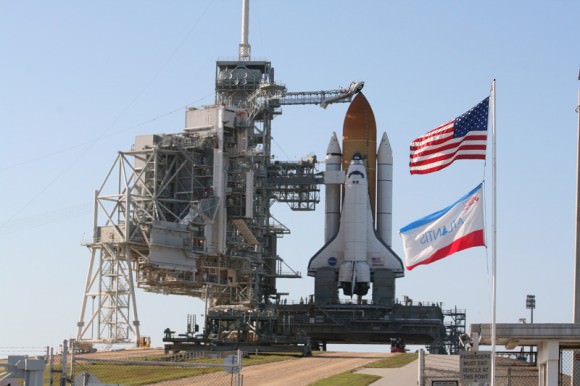
Atlantis will blast off on the final mission of the shuttle era in late June 2011. Credit: Ken Kremer
